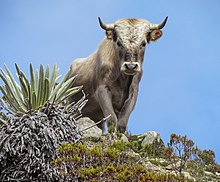Maverick (animal)
This article needs additional citations for verification. (September 2013) |

Maverick (or cleanskin) animals, usually cattle, are animals that do not carry a brand.[1]
Names
The term maverick is from Samuel Maverick, who, among his other claims to fame, was notorious for not branding his cattle.
Other U.S. terms for unbranded cattle include slick,[1] hairy dick,[2] and, in Spanish-speaking areas of the Southwest, orejano.[3] In other parts of the world, different terms are used. In Australia and New Zealand, for example, an unbranded animal is a cleanskin.[4]
History
American Old West
In the period of the United States open range, such animals were relatively common. Many cows would give birth in wild or semi-wild conditions, not be located in an annual round up, and their ensuing calf could thus grow to maturity without having been captured and branded for ownership. In the code of the American Old West, such animals could be branded and claimed by any rancher able to capture and brand the animal.[1]
Modernity
In modern times, there are few true mavericks, as most cattle run on private ranches, usually calving close to a ranch where young calves are easily captured and branded prior to being turned out to grazing leases on public lands. When a mature, unbranded animal is found today, the most common practice is to make a concerted effort to locate a possible owner, and then, if the animal cannot be identified, to put it up for public auction at a sheriff's sale, where the proceeds usually cover the cost of impounding the animal and attempting to locate an owner.
In addition to traditional hot branding, animals today may also be marked for identification by freeze branding, by tattooing, by ear tags, or by having a microchip embedded into the animal, usually in the neck.
In some cases, modern animals may be left unbranded for several reasons. This may include a desire not to have the animal marked due to its use as a show animal, particularly in the case of horses, or, in cattle, to avoid a scar on the hide if it is to be used for leatherworking. Some modern owners do not brand due to a reluctance to inflict pain on the animal.
References
- ^ a b c Slatta, Richard W. (1996). The Cowboy Encyclopedia. New York and London: W. W. Norton & Company. p. 235 (definition of Maverick). ISBN 978-0-393-31473-1. Retrieved 2009-04-26.
- ^ Adams, Ramon F. (1989). The Old-Time Cowhand. University of Nebraska Press. p. 157. ISBN 978-0-8032-5917-1. Retrieved 2009-04-27.
{{cite book}}: Cite has empty unknown parameter:|coauthors=(help) - ^ Slatta, Richard W. (1996). The Cowboy Encyclopedia. New York and London: W. W. Norton & Company. p. 267 (definition of Orejano). ISBN 978-0-393-31473-1. Retrieved 2009-04-26.
- ^ Peden, Robert (2008-11-27). "Beef farming". Te Ara: The Encyclopedia of New Zealand. New Zealand Ministry for Culture and Heritage. Retrieved 2009-04-27.
